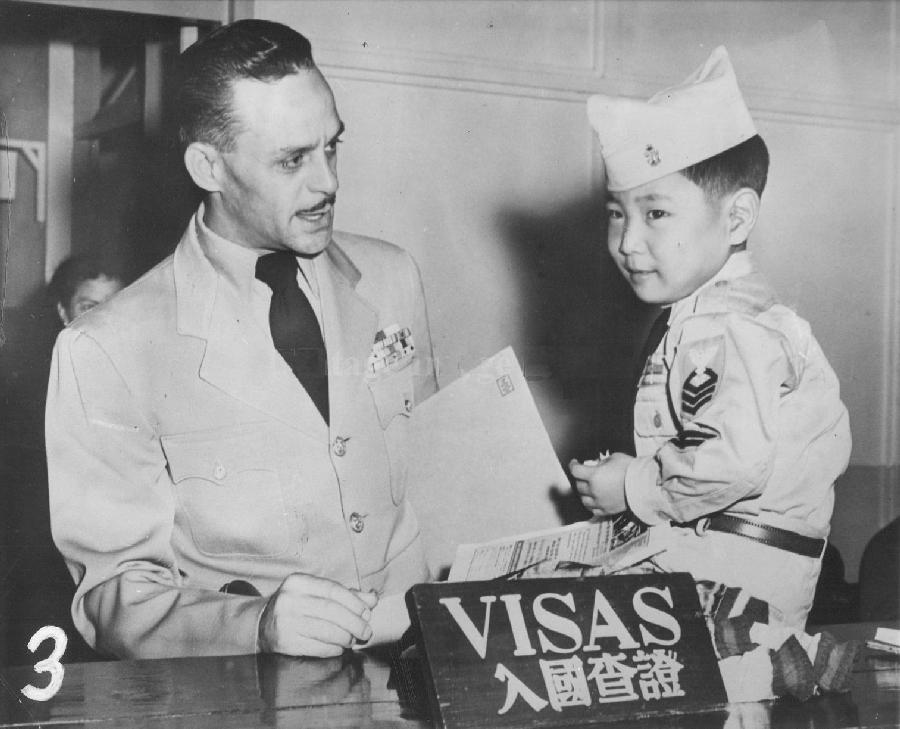
American Immigration: Korean

Figure 1.--Very few Koreans emigrated to America even after Korea was liberated from the Japanese (1945) and the Korean War (1950-53). Restrictive American immigration laws prevented entry. One of the first was this little boy--Lee Kyung Soo who almost died during the Korean War. The press caption dated January 11, 1954 reads, "Navy Bosun presents Lee Kyung Soo (1), his adopted son to the Western World and its blessings. War orpohan Lee was whisked off the streets of Invchon by Paladino a year ago, homeless, hungary, chilled intoi a stupor. (2) Now look at him. Visa difficulties halted the first attempt to bring Lee to the U.S. midway on the trip at (3) Hawaii. Adjustments cleared the way to the tike's wonderful new home in New Rochelle, N.Y. where he will be mothered by scads of adoring aunts. Paladino's sisters (4) meet natily dressed lee at Idleweid Airport, N.Y. Everything ahead is Lee's rosy apple." There were four photographs, this is #3. Note the Chinese characters on the visa sign, suggfesting that most Asian immigration at the time was Chinese. As there were Chinese Americans, there was somme possibility of family unification.
|
|
Korea was known as the Hermet Kingdom. There were little connection with the out side world or interest in it. The primary national interest was remaining indepedent from China and Japan. Foreign influences such as Christianity were brutally supressed. An effort to modernize ended the supression (late-19th cntury). Korea's modest effort to moderize was cut short by the Japanese. The Japanese brutally controlled the country until liberation by the Americans and Soviets (1945). It is at this time that a relation between America and South Korea. The United States in the Korean War prevented Communist domination. The American presence in Korea was small until the Communist North Koreans invaded (1950). At first the American-Korean relationship was limited. This was primarily with the American military presence, but economic connections began to grow as Korea developed a vibrant capitalist economy. And large numbers of Koreans began to convert to Christianity. Few Koreans emigrated, however, because of America's restrictive immigration laws. This changed when the United States reformed its immigration laws (1965). And with the ties that had developed with America, large numbers of Koreans began to emmigrte. This was before the Korean Economic Miracle began in force. South Korean would become one of the Asian Tiger economies, but at the time was still very poor as a result of a traditional society, Japanese colonization, and the Korean War. In only a few decades, some 1 million South Koreans emigrated to America and by the 1910s were over 2 percent of the immigrant population. Most South Korean immigrants are legal immigrants. Almost all came from South Korea because there was no way for North Koreans to get to America. The first Korean immigrants were mostly unskilled workers, but through hard work and educational advancement, Koreans today are one ofthe most successful immigrant groups, largely by opening small businesses. Korean immigration has leveled off because South Korea now has a vibrant economy. The number of Koreans coming to America for university study has also leveled off. A few migrants have returned to Korea in recent years, on part because of a Government program to encourage this. Much of the Korean immigrant population is found in California. North Korea does not permit emigration and the penalties for doing so are draconian, including punishment of whole families. A few North Koreans manage to cross into China, but are returned if identified by Chinese authorities. Some manage to make their way through China to other countries. The largest North Korean population is in Kazakhstan where authorities have offered them refuge.
CIH

Navigate the Children in History Website:
{Return to the Main U.S. immigration national origins page]
[Return to the Main U.S. immigration page]
[About Us]
[Introduction]
[Biographies]
[Chronology]
[Climatology]
[Clothing]
[Disease and Health]
[Economics]
[Freedom]
[Geography]
[History]
[Human Nature]
[Ideology]
[Law]
[Nationalism]
[Presidents]
[Religion]
[Royalty]
[Science]
[Social Class]
[Bibliographies]
[Contributions]
[FAQs]
[Glossaries]
[Images]
[Links]
[Registration]
[Tools]
[Children in History Home]
Created: 11:10 PM 5/4/2018
Last updated: 11:10 PM 5/4/2018



